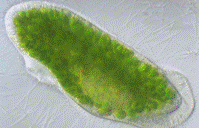Biological Sciences, School of

School of Biological Sciences: Faculty Publications
Document Type
Article
Date of this Version
2020
Citation
Ecology and Evolution (2020) 10: 1,368-1,377.
DOI: 10.1002/ece3.5990
Abstract
Abstract
The effects of climate change—such as increased temperature variability and novel predators—rarely happen in isolation, but it is unclear how organisms cope with multiple stressors simultaneously. To explore this, we grew replicate Paramecium caudatum populations in either constant or variable temperatures and exposed half to predation. We then fit thermal performance curves (TPCs) of intrinsic growth rate (rmax) for each replicate population (N = 12) across seven temperatures (10°C–38°C). TPCs of P. caudatum exposed to both temperature variability and predation responded only to one or the other (but not both), resulting in unpredictable outcomes. These changes in TPCs were accompanied by changes in cell morphology. Although cell volume was conserved across treatments, cells became narrower in response to temperature variability and rounder in response to predation. Our findings suggest that predation and temperature variability produce conflicting pressures on both thermal performance and cell morphology. Lastly, we found a strong correlation between changes in cell morphology and TPC parameters in response to predation, suggesting that responses to opposing selective pressures could be constrained by trade-offs. Our results shed new light on how environmental and ecological pressures interact to elicit changes in characteristics at both the individual and population levels. We further suggest that morphological responses to interactive environmental forces may modulate population-level responses, making prediction of long-term responses to environmental change challenging.


Comments
Copyright 2020, the authors. Open access material.
License: CC-BY.